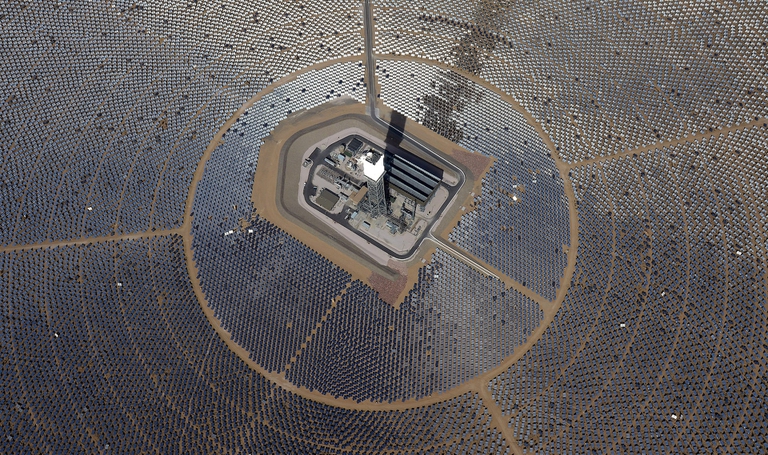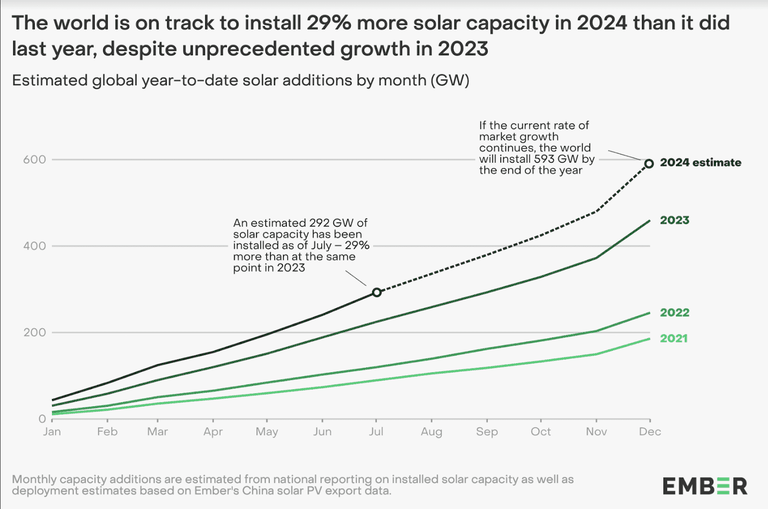https://www.lifegate.it/fotovoltaico-previsioni-2024
- |
- Forecasts for global PV installations in 2024 have been continually revised upwards.
- Leading the growth are China, the United States, India, Germany and Brazil, which are estimated to account for 75 percent of global solar energy additions by 2024.
2024 confirms itself as a year of extraordinary growth for photovoltaics.Second the new report of the energy think tank Ember, global installations of solar energy systems will exceed the most optimistic forecasts, reaching 593 GW added by the end of the year.This figure represents an increase of 29 percent compared to 2023, a year that had already seen an impressive increase of 87 percent compared to 2022.

Photovoltaic is the cheapest energy source
“Solar energy continues to grow faster than expected, confirming itself as the cheapest source of electricity globally,” says Euan Graham, electricity data analyst for Ember, underlining the astonishing pace of growth in the sector.The expert also highlights how solar growth in consolidated markets is being accompanied by an acceleration in emerging countries, bringing new installations to levels never seen before.“It is essential – added Graham – that countries plan for a future based on solar energy, to fully exploit its low-cost potential”.
Ember's analysis, based on data updated to July 2024, aligns with the already prosperous forecasts of Bloomberg new energy finance (BNEF), the team of global energy experts, and exceeds the estimates provided in January by almost 200 GW by the International Energy Agency (IEA).Other major organizations, such as SolarPower Europe, have also revised their forecasts upwards:from 401 GW in June 2023, the global outlook for 2024 was updated to 544 GW in June this year.

Photovoltaics versus coal:the comparison on energy capacity
New solar installations in 2024, according to Ember, will likely exceed total coal-fired power capacity added globally since 2010, equal to 540 GW.This data represents a crucial step forward towards achieving climate objectives, while there remains the need to maintain this pace to align with the critical threshold of 1.5°C of global warming.
The analysis highlights that 75 percent of new global solar energy installations in 2024 will be concentrated in five countries:China, United States, India, Germany and Brazil.There China confirms its dominant role in the solar market.In the first seven months of 2024, solar capacity installations grew 28 percent compared to the same period in 2023, with a forecast of 334 GW of new capacity by the end of the year, accounting for 56 percent of the global total.
THE'India, for its part, recorded an impressive 77 percent increase in photovoltaic system installations compared to the first seven months of 2023.By May 2024, the country had already surpassed the installation totals of the entire previous year, and is currently on course to add 23 GW of new capacity by December.
In the United States, the solar sector saw 55 percent growth in the first six months of 2024, with 20 GW of new installations compared to the same period the previous year.In Germany, the solar capacity target for 2024 has already been achieved, and the country is preparing to reach the new target set for 2026 in its National Energy and Climate Plan.
Future challenges:network and storage capacity
In addition to these established markets, solar is also expanding into new areas. Pakistan, Saudi Arabia, Philippines, United Arab Emirates, Thailand And Oman they are among the emerging countries that are benefiting from significant growth thanks to the export of solar technologies from China.
And in Italy?As of June 30, 2024, more than 1.7 million photovoltaic systems were connected, for a total power of 33.62 GW.In the first six months of the year, 169,003 new plants were connected for a total of 3.34 GW, a 44 percent increase compared to the first half of 2023.This is what emerges from the elaborations of Solar Italy, based on Terna's Gaudì data.
Despite the extraordinary progress, challenges remain to be addressed to ensure sustainable growth of solar energy.The capacity of electricity networks and the development of battery storage systems will be crucial to manage energy distribution and cover the hours when solar production is not at its maximum.If these obstacles are adequately addressed, Ember notes, solar energy is poised to further exceed expectations for the rest of the decade, cementing its role as a pillar of energy transition global.
